Sektionsleiter | Section Chairs: Chin SangBum (Comperative Study of the World Literature in Korea), Doo Haeng-Sook (Universität Sogang, Seoul)
| Internet-Zeitschrift für Kulturwissenschaften | 17. Nr. | Februar 2010 | |
| Sektion 1.12. | Asien und deutsche sowie österreichische Kunst und Literatur um die Jahrhundertwende: Einflüsse und Bedeutung Sektionsleiter | Section Chairs: Chin SangBum (Comperative Study of the World Literature in Korea), Doo Haeng-Sook (Universität Sogang, Seoul) |
||
The Art of Art Nouveau and Asia –
centering on Gustav Klimt
Lee Heju (Jeonju University, Korea) [BIO]
Email: Leejeju1@hanmail.net
Introduction
At the end of the 1890ies, the so-called fin de siecle, Gustav Klimt did not compromise with Austrian artistic tradition but established a unique art world of his own without ever being satisfied with his artistical temperament and talent.(1) Klimt enjoyed reading books and, lead a regular life regarding his artistic production. He communicated freely between dream and reality in figurative language. He devoted himself to creating his unique art, drawing out his fantastic world into the visual world of consciousness. Klimt was a painter with a keen artistic spirit of exploration and escaped from the Austrian Künstler Gruppe Verein, which dominated the art scene at that time, practicing his artistic exploratory spirit. He became the first president of the group Secession. in which he reformed the existing corrupt system and pursued a new art. At that time Jugendstil was a New Art movement, which was highly fashion. Jugendstil was a new stream of art, in which decorative and graphic lines, clear and bright colors, two-dimensional forms and elements of decoration were pursued. Jugendstil was an avant-garde stream of art with the perspective of a return to nature, influenced by Japanese art, and is regarded as a form of unity between life and Art.(2) Klimt adopted lineal forms, the two-dimensional forms, decorative elements and symbolism into mythical images. In this process he received Asian motifs and created his original world of Jugendstil art. Young Artist Egon Schiele visited the Klimt's gallery shortly before his death. The description of his visit shows how deep Klimt's interest in Far Eastern Art was: "The quiet small gallery near the street of Hietzing in Vienna is surrounded with big trees and fields full of flowers. Japanese woodcuts and two big Chinese paintings can be seen in the interior of the house on the wall.(3)Klimt-researcher Maria Constantino states that Klimt's representative designs produced since 1900 were extracted from East Asian art collections, In particular, the background of Klimt's portrait series were decorated with images of characters from art works of China, Japan and Korea. This is a good evidence for the relationship between Klimt and Far East Art. The Asia concept adopted in this paper, always means the Far East including China, Japan and Korea. It means the perspective of Eastern Aesthetics, which pursues lineal beauty and affinity to nature, decoration and symbolism.
Austrian representative Jugendstil artist Klimt was influenced by Far Eastern art, but a new turning point in his art has not been clarified as yet. So far only the influence of Japanese art has been dealt with.(4)There are no papers on the relationship with Korean Art and Asia. However, Maria Constantino expressly stated that Klimt was not only influenced by the art of Japan and China but also by art of Korea. As result, Klimt used the substance of Eastern expression as motifs in the background of his works. Friederike, Klimt's model in his work Portrait of Friederike Maria Beer, confessed that the background of Klimt's above mentioned picture was extracted from decoration of Korean porcelain among the art collection displayed in the outer work shop.(5)
Today's world is becoming more and more globalized, There has been and is mutual influence from East and West, This paper investigates academic evidence that the East provided a breakthrough for the then-time avant-garde art stream Jugendstil. I will analyze Jugendstil's Eastern tendency. I will examine the origin of Eastern elements and analyze what kind of relationship between this Eastern tendency and Korean folk art exists.
I. Eastern tendency in Klimt's artistic world
In the history of Asia reception, China was European artist first object of interest before their interest turned to Japan. Klimt found decorative matter in Chinese clothes and owned many Chinese clothes in his wardrobe. He had access to a lot of information on Chinese clothes, which were in fashion at the time, through his companion Emil Floege. After taking photos of figures dressed in Chinese garments, he used to draw them.(6) It is evident that the wave pattern and flower designs originating in China influenced the decoration of clothes appearing in his work Portrait of Baroness Elisabeth (pic. 1) In 1906, Klimt bought a book called Japanese Art written by Bing, After that he travelled to Brussels to observe Japanese art collections and began to research it.
 |
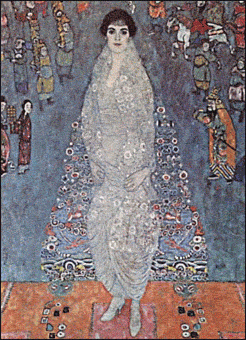 |
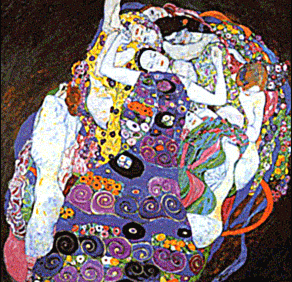 |
pic. 1: Portrait of Friederike Maria Beer |
pic. 2: Portrait of Baroness Elisabeth |
pic. 3: The Virgin |
Analyzing the Japanese influence Klimt's works, we can find that Japanese masks influenced his work The Virgin (pic. 2)(7). The image of the face in the right upper part of this picture reminds us of a Japanese mask. Also, the decoration of the woman wearing a Japanese kimono, the flower design and the line flowing like a wave appearing in his work Portrait of a Lady (pic. 4) are reminiscent of Japanese traditional clothes.(8)
Thirdly. Klimt was fascinated with the form of the Japanese kimono and adopted the S line in his work.
 |
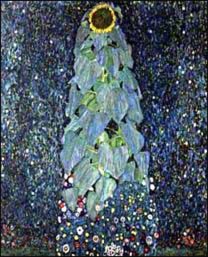 |
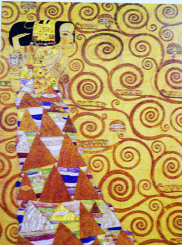 |
pic. 4: Portrait of a Lady |
pic. 5: The Sunflower |
pic. 6: Expectation |
A fourth aspect is the triangle design engraved on the costumes used in NO theater, which appears in Klimt's work Expectation (pic.6).
Klimt showed his figures close-up just like Japanese traditional paintings do. In getting rid of detailed descriptions in the background, he adopted Japanese patterns in order to express his figurative language. Klimt handled the background as a plane and arranged Japanese patterns to make elegant and refined compositions. These points can be considered as Japanese influence
In the next section I will examine the relationship between the Eastern tendency in Klimt's works and Korean folk art "Minhwa".
II. Analysis of Eastern tendency in Klimt's works
1. Affinity to nature
Klimt rejected the repetition and imitation of past traditional art and received the basic spirit of Jugendstil, which tries to return to a more fundamental condition existing in all organic bodies of life(9). IIn Jugendstil, the beauty of every form can be reproduced in unity with nature. The artists of Jugendstil recognized that beauty cannot be created in discord with nature. This idea was handed down from the traditional nature movement. Jugendstil developed modern design just like Secession, Art Deco and Bauhaus, through which Morris has greatly influenced the European continent. Klimt collected Japanese drawings, Chinese and Korean art of crafts and books. He thoroughly studies this material and was fascinated with Asian thought. Klimt was able to deepen his knowledge on Asian art through his companion Emil Floege. He enjoyed putting on loose clothes as in Japanese traditional No theater. He tried to lead a life close to nature and, enjoyed drawing in harmony with nature in Upper Austria, where the beautiful lake Atersee is surrounded by beautiful scenery.(10)In his drawings he hinted that Man must return to nature as the law of all organic phenomena. Klimt felt reverence towards the inner peace of nature. He was deeply interested in the essential beauty transcending form beyond conscious sight. Klimt tried to escape from character expressed as aesthetic object. He expressly said that his strong desire to obtain freedom was his motivation to make a change in the reception of aesthetic recognition. From 1911 on, Klimt drew many landscape paintings, concentrating on the composition of the essence of the object existing hidden under the outside scenery. He continued to more and more realize the structure of the hidden side. Nature as expressed by Klimt was to deepen to express the inner side and a return to the self, and expression of the inner mind. Klimt enjoyed the peace of mind and shelter which Nature and his companion Emil Floege offered. Klimt created original compositions with a fresh sense of color. He used color like the blank space in Asian painting. In such repeatedly expressed phenomena as tree stems Klimt described nature's inner world. Berta Zuckerkandl compared Klimt's landscape paintings to Schubert's colorful melodies and called him Austria's greatest artist. Many of his works show landscape drawings expressing ecstasy deeply rooted in nature. In the twilight years of his life Klimt produced a great amount of landscape drawings, especially from 1911 on. For the first time this can be seen in his work The Park. Klimt created The Tree of Life (Picture 7) and Fulfillment (Picture 8), in which the spiral decoration covering the background of the picture is expressed more strikingly than any character. The decoration covering the side of the wall moves towards the branches of the tree. The branches of the tree revolute into archetypal resources. This emphasizes the peaceful state of nature more than the process of growth.(11) The Sunflower (Picture 3) gives us the feeling that a person is involved in and intertwined with nature just like his picture The Kiss (Picture 9). In The Kiss the nature motif is used. The beautiful flower and the plant's extension shown in the underpart of the two lovers' figures makes us feel at one with the two lovers' intoxicated enchantment with each other. The Sunflower is a good example of a picture with nature-affinity as though the picture is absorbed into with nature, Vienna poet Peter Altenberg, Klimt's contemporary, pointed out that Klimt drew this picture as if longing for a woman.(12)
 |
 |
 |
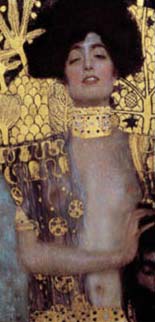 |
pic. 7: The Tree of Life |
pic.8: Fulfillment |
pic. 9: The Kiss |
pic. 10: Judith I |
The pattern of tree and mountain in The Kiss, Judith I (Picture 9, 10), the form of a tree in The Tree of Life (pic. 7) appear as background motifs in Klimt's late works. The reason for the appearance of nature in his drawing board can be found in Klimt's way of thinking way, which shows a tendency to integrate the elemental living body of nature in Jugendstil. On the other side, Klimt adopted Asian subjects like flower, mountain, waves etc. into his late works, which he received form the Asian view of the world. In Klimt's work Friend (pic. 14) a peony blossom is used as the background of the figure – a motif which commonly appears in Korean folk art. The peony blossom is frequently used as a subject in Chinese and Japanese drawings. The flower is shown again in The Tree of Life as subject matter: expressing the leaves of the plant geometrically, the flower is arranged in white color just like Korean folk art Gam-Mo-Yeo-Je-Do (Picture 11). This, too, is an Asian Image. Natural motifs are due to the natural view of the world, in which the Chinese, Japanese and Korean love nature and coexist in harmony with it. This can be considered as a clear expression of the Asian thought of nature affinity, in which Man and Nature coexist in harmony.
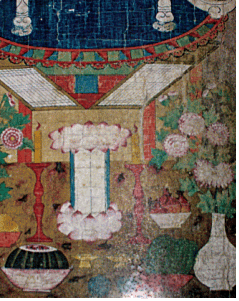 |
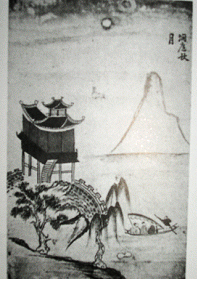 |
|
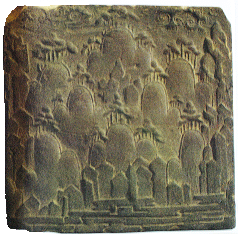 |
||
pic. 11: Gam-Mo-Yo-Je-Do |
pic. 12: Dong Jong-Ho under moonlight |
pic. 13: San-Su-Mun-Jeon |
Korean folk art relies more on nature than on man. By following the way of Korean folk art, people participated in the world of harmony. Participation in harmony means to find unity in the harmony of the cosmos and natural order. This is the act of creation; we can understand that the background of Korean cultural art is founded on this trust in nature generally.
In Korean folk art, e.g. Dong-Jong-Ho under Moonlight (Picture 12), the recognition of cosmic mysticism and the Tao of Yin and Yang are expressed in the night play at the dream lake. Klimt's work Judith I shows a mountain and an arabesque design as the background of the picture. It is not difficult to find such the arabesque designs in Asian porcelain and paintings like the above mentioned Korean folk art San-Su-Mun-Jeon (Picture 13).
Appreciating the above mentioned points synthetically, Klimt's nature affinity has something in common with the Asian view of nature, which is the nature affinity that Jugendstil pursues.
2. Decoration
Klimt successfully produced pictures of decoration and became famous as a sensitive painter of portraits. In 1894, beginning with the painting of faculty pictures for the auditorium of Vienna University as new experimental attempt against traditional European painting, he came to enjoy creating decorative expressions with symbols and eroticism. In his art there is no identity to life, but rather pleasant decorative elements. From his university days he was acknowledged as artistically talented and was asked to participate in the enlarging of some window designs of the Ringstrasse Votivkirche and later to conduct some refined archaeological work. He was trained to create historistic paintings and fresco. He became a prominent painter with his brother Ernst Klimt by creating museum frescoes and curtains of theater stages by applying a mixed technique of Greek Byzantine art and Japanese woodcut. Klimt was also requested to make a new theater decoration for the New Burgtheater. He had to show the development of image from ancient Egyptian art to 16th century art.
Klimt's decorative art is unique. He used natural motifs for symbolic expression as characteristics of Art Nouveau and the world of idea. Figurative structures like mountain, pillar, flower, cloud, blue grass can be recognized as flexible and inactive arabesque decorative designs, symbol, idealistic color, iconography, subject and object, spiritual sensitivity and sense. It shows his desire for expression. He pursued the universal analogy of nature as expression of the harmonious world of beauty as the ultimate goal of his art.(13) Escaping from the existing academic tradition of Austrian art, Klimt attempted to show a new spirit of creation by expressing refined and fantastic figurative language in his decorative painting. Great mystic craftsmanship temperament overwhelmed with vital feeling and sincerity are unified and transcended into a simple field of decoration in his form of Jugendstil. Natural motifs, idealistic color and iconography appeared in his art - these are derived from the middle ages and primitive art. It coincided with the purpose of Abstract Art which pursued abstraction on foundation of lineal rhythm. Just like the decoration of image in Portrait of Friederike Maria Beer (picture 1), Klimt made symbolic decoration in his portrait paintings which show many Viennese women. In his late and most gorgeous portrait Portrait of Friederike Maria Beer, he adopted Eastern subject matter and created an Eastern war scene as the background of the drawing board. The model of this portrait wears clothes made in the Vienna workshop put on in reversed order in order to give a gorgeous decorated impression. Various designs and colors fuse with the figure perfectly in a brilliant, vital and visual decoration system. As result he became the most prominent painter of the 20th century.(14)
The most representative work of his artistic sense might well be his painting Stoclet Freeze. We understand that more comprehensive artistical objects exist. Art is not limited to the category of individual activity any more. Art can be understood as means to create a form in the category of all activities. With the effort which tries to enlarge all arts, the artist creates form, seizing an opportunity decisively.(15)Decorative design, the flow of the line covered on the background of the drawing board, the composition show an Eastern tendency and the process of adopting Art Nouveau tendencies, which aims to pursue the practicalization of all art.
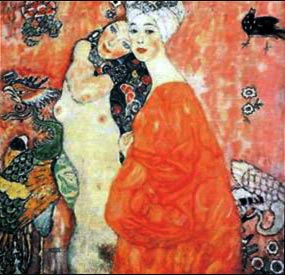 |
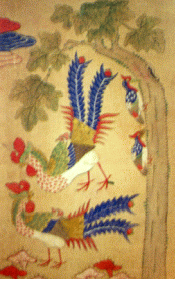 |
pic. 14: Friends | pic. 15: Bong- Hwang- Do |
Klimt received the Naturalist point of view, which stresses the decoration of Art Nouveau and resulted in a decorative effect in his painting. He created many decorative pictures and in his late stage produced many pictures with Eastern tendency. In particular, he adopted Eastern aesthetics and used many Eastern motifs in his decorative painting. Klimt's picture Friends (picture 14) reminds us of the Korean folk art picture Bong-Hwang-Do (picture 15). The bird in Klimt's above mentioned painting appears like the Bong- Hwang- Do in Korean folk art. Klimt depicted the wing and bill by making a contrast of intensive color and clear outline, omitting the shadow of the bird, and filled out the bright and dark side with color. In particular, the colorful yellow and the head part of red and blue appear as the five Eastern colors.
We can approach Korean folk art in both aspects of decorative painting and decoration. Korean folk art originates to a large part from interior decoration and habits of life. In accordance with people's practical requests, painters produced practical paintings full of animistic folk faith and symbolism. Our ancestors enjoyed folk paintings on the wall for decorative reasons as well as practical reasons, but both uses combine the external decoration in itself.
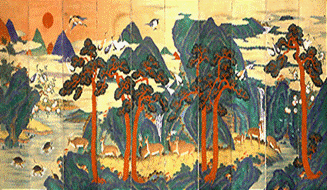 |
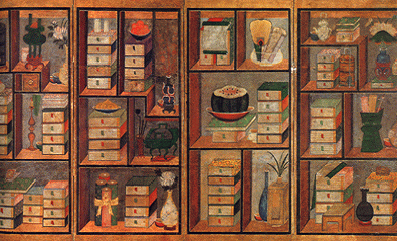 |
| pic. 16: Jin-Chae-Sip-Jang-Seng-Do | pic. 17: Cheg-Geo-Ri-Do |
The Korean folk paintings Jin-Chae-Sib-Jang-Seng-Do (pic. 16), Cheg-Geo-Ri-Do (pic. 17), Hoa-Jo-Do (pic. 16), Hai-Hag-Ban-Jo-Do (pic. 18) are very expressive, refined and brilliant, using the five colours for creating various decorations. In particular in Klimt's painting,
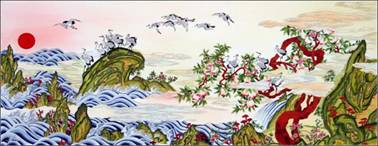 |
| pic. 18: Hae-Hag-Ban-Jo-Do |
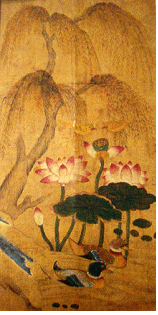 |
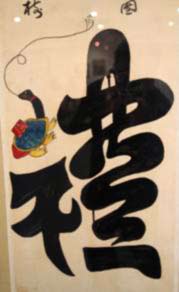 |
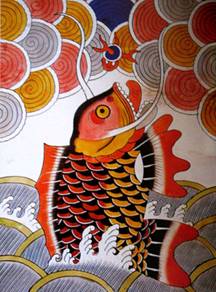 |
| pic. 19: Hwa-Jo-Do | pic. 20: Mun-Ja-Do |
pic. 21: Yak-Ri-Do |
Mun-Ja-Do (pic. 20) we can find that although the painting faithfully depicts the letters according to historical facts, the composition of these letters with their powerful strokes and colorful decoration reduces them to decorative design rather than actual letters. In result, the above mentioned painting as such turns into a decorative painting just like Korean folk art Mun-Ja-Do (pic. 20). From this we can learn that in the case of pictures handling the same subject matter, these can be considered decorative according to share of composition and color.
In creating decoration in Korean folk art, the cosmic five colors are the most important element. Our ancestors created resentment, fun, humor and fantastic decoration through the confrontation of the five cosmic colors which in turn are derived from movement of Yin and Yang.
By depicting a decorative and fantastic figurative language, Klimt's paintings obtain brilliant decoration, in which the craftsman's temperament and sincerity overwhelmed with mystic and vital feeling are unified.
3. Symbolism
Klimt symbolically expressed the feminity and cosmic mythical art. He despaired of the use of the fixed and empty allegorical language, which comtemporary artists continued to use in order to express difficult ideas into living, vital pictural language.
Klimt pursued aesthetics of ambiguity like the French impressionists Moro and Redon. He believed that the deep mystics of life can be transferred only by metaphor and hint. Klimt's symbolism can be regarded as the result of his attempt to depict his desire of expression metaphorically according to the form of Jugendstil. His symbolic technique was emphasized in his late works. He enlarged the movement of Jugendstil, in which Asian techniques were adopted. His works reveal many Asian motifs and symbolic titles. The same phenomena of expression can be found in China, Japan and Korea.
The symbolic meaning hidden in Korean Folk art can be regarded as another important element in addition to the material shown itself. Our ancestors believed that the symbol is the ultimate goal. Our ancestors believed that the symbol is the ultimate goal and of ultimate value. Thus, all animals appearing in Korean Folk art – whether real or imagined – have a unique symbolic meaning.Jin-Chae-Sip-Jang-Seng-Do (pic. 16) shows the ten symbols of long life, Mo-Ran-Do depicts the symbols of long life and wealth, Yag-Ri-Do (pic 21) shows social success and the conception of a son. Seog-Ryu-Do (pic. 22) depicts the conception of many sons. The turtle, for example, is a symbolic animal of long life as are crane and deer. Sun, cloud, mountain, rock, water, pine tree, bamboo, and grass are symbols for eternal life as is the peach. Together they form the so-called Syb-Jang-Seng, conveying the wish for a long life without diseases. These symbols in the profane world can be perceived as our dream and beauty. Korean folk art has been loved by the general public for this reason.
|
|
|
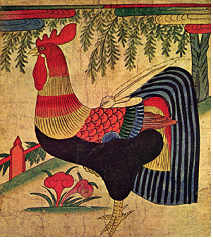 |
||
| pic. 18: Seog-Ryu-Do | pic. 19: Goe-Seok-Mo-Ran-Do | pic. 20:Joo-Jak-Do |
In Korean folk art paintingGoe-Seok-Mo-Ran-Do (pic. 19) the strange rock is depicted under a peony blossom, which is called the king of flowers. The strange rock is shown in blue and red. The strange rock in blue symbolizes man, the strange rock in red symbolizes woman. Peony blossom and folding screen meas wealth, peaceful life and the harmony between man and woman. Therefore, this picture has mostly been used for wedding ceremonies and the women quarters. Although the symbolism is derived according to the characteristic quality of the thing shown, the symbols are created on the principle of the five Yin-Yang movements and cosmic colours. The cock in Joo-Jak-Do (pic. 20) has been considered and entertained as a bird of good omen, announcing the time of dawn. Of the twelve zodiac animals only the cock has wings and is thus the symbolic messenger between heaven and earth. When a cock cries, dawn breaks and the minor demons flee in fear of bright light. In this sense, it has religious meaning. The hen as poultry, which hatches an egg every day, symbolizes sons and posterity. The hen in Korean Folk art has symbolic meaning, signaling shaman power and harmonious relationship between man and woman. Pictures which show cockscombs - a cock with a crown – symbolize social success and steep social careers.
Korean Folk art bookshelf pictures were hung in the scholars' studies or private schools of the Chinese Classics. They symbolize science and the virtue of learning. Mun-Bang-Do, Mun-Bang-Sa-U-Do can also be called Gi-Myong-Hwa, Gi-Yong-Do. Chae-Tak-Mun-Bang-Do, Chae-Ga-Do, or 'Chaek-Geo-Ri' in pure Korean. The bookshelf pictures do not only show Mu-Bang-Sa-U(16), but also things used by scholars in ordinary life like Go (Baduk)boards, fruits, wine bottles and glasses, tobacco pipes, and even skirts, cucumbers and other things symbolizing sex. Books with different titles proudly proclaim the master's virtue and the depth as well as his elegant hobbies and taste. These pictures contains convey the wish for learning and study.
 |
 |
|
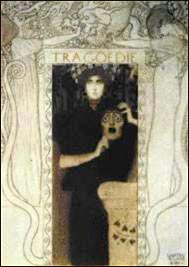 |
||
| pic. 21: Eo-Hae-Do | pic. 22: Tragedy |
pic. 23: Un-Ryong-Do |
Korean Folk art paintings Eo-Hae-Do (pic. 21) show different kind of fish and symbolize happiness and the conception of sons..(17) Hwa-Jo-Do (pic. 19) pictures depict scenes of flower and bird. Where flowers exist, butterflies and birds appear. Pairs of birds in friendly harmony are the expression of the metaphorical wish for a harmonious relationship between man and woman. The dragon in Korean Folk art pictures Un-Ryong-Do (picture 23) is a symbolical animal of good omen, elegant and mystic.
Klimt's picture Tragedy (picture 22) symbolizes the duality of the inner and outward character. Part of Klimt's pictures – stocket Friez, Expectation (picture 6), The Tree of Life (picture 7) Fulfillment (picture 8) – show man and flower, bird etc playing in harmony, as if man and woman were one with Nature. Every living thing longs for and expects to feel happiness and in fulfillment. Klimt's The Kiss (pic. 9) shows two lovers with their endless yearning of unity fulfillment. This picture contains various symbolic meanings.
The symbolic elements n Klimt's works are deeply related to the general stream at that time. We come to the conclusion that Klimt's work shows us the symbolic element represented in Korean folk art.
III. Conclusion
Klimt presented us with world of painting, in which affinity with nature, decoration and symbolism are pursued. He adopted Eastern aesthetics and enlarged the horizon of Jugendstil art. Klimt came in contact with Chinese, Japanese and Korean art and became deeply interested in collecting Asian art. This motivated him to develop his artistical world. Due to this background, common characteristics like affinity to nature, decoration and symbolism which appear in Korean Folk art are shown in Klimt's works.
Eastern subject matter like the Chinese phoenix (pic. 13), arabesque patterns, the image of horse riding appeared in Klimt's works. His picture Friderike Beer, which can be regarded as influenced by Korean porcelain, uses general and brilliant colours and thick and soft lines, which we associate with the five Korean cosmic colours. Korean Folk art and Klimt's works show similar phenomena in expressing the artistical aesthetics of nature affinity, decoration and symbolism.
Notes:
1.12. Asien und deutsche sowie österreichische Kunst und Literatur um die Jahrhundertwende: Einflüsse und Bedeutung
Sektionsgruppen | Section Groups | Groupes de sections
| Inhalt | Table of Contents | Contenu 17 Nr. |
Webmeister: Gerald Mach last change: 2010-03-11